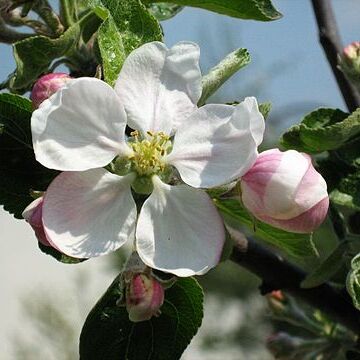Trees small, 4–6 m tall. Branchlets purplish brown when old, terete, robust, densely pubescent when young, glabrous when old; buds grayish red, ovoid, initially densely pubescent, glabrescent. Stipules caducous, lanceolate, small, 3–5 mm, membranous, margin glandular serrate when young, apex acuminate; petiole 1.5–5 cm, puberulous; leaf blade ovate or elliptic, 5–11 × 4–5.5 cm, abaxially densely puberulous, adaxially initially puberulous, glabrescent, base rounded or broadly cuneate, margin serrulate, apex acute or acuminate. Corymb at apices of branchlets, umbel-like, 3–5 cm in diam., 4–7(–10)-flowered; bracts caducous, lanceolate, membranous, pubescent, apex acuminate. Pedicel 1.5–2 cm, densely pubescent. Flowers 3–4 cm in diam. Hypanthium densely pubescent abaxially. Sepals triangular-lanceolate, 4–5 mm, slightly longer than hypanthium, both surfaces densely pubescent, margin entire, apex acuminate. Petals pinkish, obovate or oblong-obovate, 0.8–1.3 cm, base shortly clawed, apex rounded. Stamens 17–20, unequal, shorter than petals. Ovary 4-or 5-loculed, with 2 ovules per locule; styles 4(or 5), longer than stamens, tomentose basally. Pome yellow or red, ovoid or subglobose, 4–5 cm in diam., impressed at base; fruiting pedicel 1.5–2.5 cm, pubescent; sepals persistent. Fl. Apr–May, fr. Aug–Sep. 2n = 34*, 51*, 68*.
More
A small tree. It loses its leaves during the year. It grows 4-6 m high. The young branches are stout and hairy. The leaves are narrowly oval and 5-11 cm long by 4-6 cm wide. There are fine teeth along the edge. They are densely hairy underneath. The flowers are pink and 3-4 cm across. The fruit are a flattened round shape. They are 4-5 cm across. They are yellow with a tinge of red. There are many cultivars.
Can be grown by cuttings or seedlings. Seeds needs stratification.

